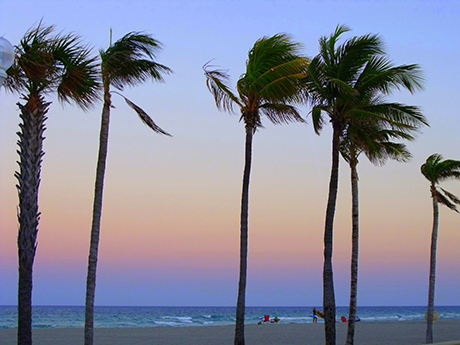
The city of Hollywood, Florida, is transforming. Once best known for its pristine beaches and as the winter home to many French Canadians, the area is becoming a magnet for new arrivals from the Northeast, Texas and California seeking a better place to live and do business.
Hollywood’s mayor and city commissioners are showing their support for multifamily development, which will result in half a dozen projects being completed in 2025.
Why are people choosing Hollywood and not Fort Lauderdale or well-known Miami neighborhoods like Brickell and Wynwood? Because the city has better rental rates and home prices while still providing everything South Florida can offer.
Average rents in Hollywood are approximately $36 per square foot, making it more competitive than Fort Lauderdale, where rents average $37 per square foot. With year-over-year rent growth of 3 percent — just ahead of the greater metro-wide increase of 2.9 percent — the city of Hollywood stands out as a resilient and expanding market.
Hollywood is well-situated just south of Fort Lauderdale and north of Aventura, the most fashionable city in Miami-Dade County. It’s a few minutes from a growing airport, a busy port, a healthcare complex, which includes Joe DiMaggio Children’s Hospital, and the beach. The city is situated between two main travel corridors, Interstate 95 and Florida’s Turnpike. Key West lies to the south and Disney World to the north.
The location and government support are spurring a fast-growing number of residential projects. In December, the Broward County Commission unanimously approved a land-use plan amendment allowing residential construction on 34 acres that were once a dump site. The mixed-use community of five buildings will have 618 apartments, some set aside for workforce housing and office and retail space.
Real estate investors and developers are gravitating toward Hollywood because of price. In downtown Hollywood, a stylish residential project can cost $700 to $900 per square foot to develop. Something equal to that in Aventura or Fort Lauderdale would cost $1,000 or more per square foot.
New Law Paves Way for Development
Examples of Hollywood’s popularity abound. Three developers have joined forces to propose Park Road on 30 acres of city-owned land. Plans call for 620 apartments across six five-story buildings.
A different developer intends to build a 198-unit affordable housing project near the Seminole Hard Rock Hotel & Casino. Florida’s new Live Local Act, which provides incentives for including affordable housing in projects, spurred that action.
The Live Local Act went into effect July 1, 2023. The law states that local governments are required to allow affordable housing developments in commercial, industrial and mixed-use zoning districts.
Developers are finding opportunities elsewhere in Hollywood. Projects now under construction, most of them mixed-use, include:
- University Station, a mixed-income development with 216 affordable housing units.
- Soleste Hollywood Blvd, Soleste Hollywood Village North and South with more than 800 apartments among the three projects.
- The Tropic, an 18-story building with 223 units, including workforce housing.
- Revv Hollywood along the city’s main street, Hollywood Boulevard, with 180 residential units.
- The Bread Building, a redevelopment site with 362 multifamily units.
- The Residences at Beverly Park, with 115 affordable units in an 11-story building.
- Pinnacle 441’s second phase, which will include 100 affordable housing rental units to complement the 113 apartments in the first phase.
There’s a recent trend among developers to plan condominium communities. The reasons are mainly economic, such as the greater ease of obtaining lender financing.
However, condo buyers are often corporate entities and foreign investors who rent the units, making the new buildings more like multifamily properties. At my residential project, One Hollywood Residences, for example, 60 percent of buyers are foreign investors, 20 percent of tenants are moving from another state, and the remaining 20 percent or so live in another part of South Florida and are moving to Hollywood for a better quality of life. The investors come from South America, Mexico, Europe and Israel.
City leaders like condominium projects in part because they tend to be more stylish in appearance. Politicians and planners believe they enhance the city’s image and help make Hollywood a destination with a pleasant atmosphere that includes a walkable downtown.
Last year, the city finished updating a large section of Hollywood Boulevard to encourage development. It is investing more than $100 million in a new police headquarters and an art education center. Hollywood has established five property improvement programs, two opportunity zones and two CRA districts.
Over the next several years, most residential development will occur downtown. The type and scope of future projects will depend on the number of investors, their funding and how quickly they move forward. As a result, the cost of land will rise. It has doubled in the past three or four years.
As multifamily projects coming out of the ground now near full occupancy, we will see business growth. Residential developers are anticipating that growth by incorporating office and retail space into their plans.
Healthcare and engineering services are growing, and the city already has established interior design and artist communities. Because so many arrivals are attracted to the South Florida lifestyle, more restaurants, retail establishments and hotels will follow.
People will come for the relaxed atmosphere in a place where everything is within easy reach. Residents walk to restaurants and stores and travel to the beach by car in 10 minutes. With a population of about 153,000, Hollywood is not a major metro. It has lower prices and less traffic congestion than downtown Miami or Fort Lauderdale.
That appeals to young families, who are more budget-conscious than wealthy retirees and corporate executives moving from the Northeast or California. According to several companies that rate the livability of cities, the crime rate has been steadily falling from its peak in 2010.
With an unemployment rate of 3.3 percent, a lower cost and higher quality of living and a rapidly growing number of housing choices, the choice is clear for many people. Multifamily developers and operators are being attracted to Hollywood, too, with no end in sight.
— Alejandro Ensinck is managing director of Doral, Florida-based Star Developers Group. He can be reached at [email protected].


